Magnus: Robot Fighter #1 ($3.99, Dynamite)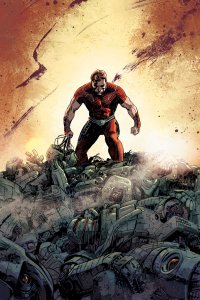
by D.S. Randlett (@dsrandlett)
Magnus never had too big of an impact on me as a kid. Looking back on many of the Valiant version of the character, it always seemed like he was a character that made for a better cover than a story. Once you saw the guy slice through a robots with his fists, what more did you want? Not that there wasn’t a narrative there, but it was a narrative with a certain trap in terms of its scope. Magnus lives in a world (specifically, the megacity of North-Am) where humans are enslaved by robots, and he must free the humans. The problem, from the perspective of ongoing heroic story telling, is that Magnus must eventually reach that end point or else he just looks inept, and once he reaches his goal there’s nowhere else for the character to really go.
So here we are with a new Magnus ongoing by Fred Van Lente (writer of the incredible Archer and Armstrong reboot) and artist Cory Smith. The story here is very much of a piece with the old setup, but with some fun fish out of water touches thrown in. We start off seeing Magnus living life in an idyllic town that is at once rural and suburban, the kind of place where one can walk to the local shops on the way to one’s favorite fishing hole. The kind of place that doesn’t exist, especially since it’s a simulacrum generated by the benevolent intelligence 1-A for the benefit of Magnus. For what purpose? That is unknown. Of course, it isn’t long before Magnus is rudely awakened to the real world by the interference of a robotic SWAT team looking to punish 1-A for his crimes. Plunged into a clustered cityscape, Magnus must find out about the truth of his surroundings and himself. He might be able to find the answers from a woman named Leeja – if she doesn’t kill him first.
Van Lente’s script is typical first issue stuff, and it isn’t quite the home run that the first relaunched Gold Key title – Turok – was, but it seeds enough mystery into Magnus’ surroundings and Magnus himself to provide fuel for compelling stories down the line. What were 1-A’s designs for him? Why can he tear through robots with his bare hands? Why does Leeja Del want him captured or dead? Van Lente keeps enough of the classic Magnus to satisfy the primal fascination with the character (He fucks up robots with his fists! He fights for freedom!) while adding some shades of ambiguity and mystery to the human/robot conflict and twists to the science fiction elements that prior iterations of Magnus have lacked. But for all that, the writing here just feels typical and not quite up to Van Lente’s standards. It feels as if he hasn’t quite found these characters yet, and there’s a dramatic beat near the end that feels kind of tacked on and unearned.
The art has a very fitting old school pulp vibe to it, despite an injection of cartoonier aspects. Cory Smith’s art looks like a Magnus comic from the world of The Iron Giant, taking on a sort of Brad Bird look in the earlier “suburb” scenes. When the book shifts gears into the robot controlled future, Smith adopts something that’s a cross between Blade Runner and a Silver Age Legion comic. Many of Smith’s choices are sound, but the art, like the script, lacks a certain energy that keeps the book from really popping, narratively or aesthetically.
Magnus definitely has room to grow and a voice to find, but it at least has narrative places to grow into. As it stands, fans of the character will likely be satisfied, but others might want to wait a few issues (or for the first trade) to see if the series fills itself out.
Rating: 




Out of a Possible 5 Stars
Twisted Light graphic novel (T Publications, $2.99)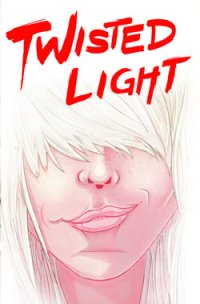
By Cat Taylor
Although I haven’t read Neil Gibson’s horror anthology comic, Twisted Dark, I did just read Twisted Light. In the foreword, Gibson explains that he wrote Twisted Light to give his friends and family who weren’t into horror something they could enjoy. I feel somewhat fortunate to have not read Twisted Dark prior to doing this review because I have the feeling I would be at least subliminally comparing Gibson’s strengths and weaknesses as a comedy writer to his abilities as a horror writer. Not having that comparison allows me to evaluate this book strictly on its own merits.
Most anthology comics vary greatly in quality due to the numerous artists and writers contributing material. However, while Twisted Light does have a different artist for each story, all of the stories are written by the same writer. This is both a strength and weakness. It’s a strength because Gibson is the kind of writer who knows how to select artists who are proficient at converting his words into sequential art that has appropriate narrative pacing to convey the story’s spirit and message. Also, Gibson is an expert at dialogue that makes each character’s voice seem natural. However, the weakness in Gibson writing all of these stories is that he has very little thematic diversity. Most of the “punchlines” of the stories in Twisted Light involve supposedly ironic twist conclusions that you not only see coming a mile away, but are often the same “ironic twist” ending told with different characters. When Gibson breaks away from repetitive stories involving authority figures, he does his best work. My favorite was the one about a hypnotist that is the second story in this collection. It’s odd that Gibson is such a good storyteller but too often relies on using the same clichéd endings. I feel like he would be superb at translating the plots of others to the comic book medium. He should probably include the work of other writers alongside his own work before publishing another anthology.
As a comedy anthology, Twisted Light isn’t really what I’d consider to be a “funny” book but it has a light-hearted tone that I thought was “fun” to read. More than anything, Gibson’s strength in storytelling and conveying the voices of his characters makes me interested in checking out Twisted Dark. I wonder if he might have more original ideas and endings for his horror stories.
Rating: 




Out of a Possible 5 Stars
Captain Marvel #1 (Marvel, $3.99)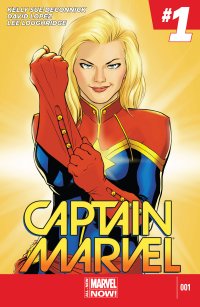
Secret Avengers #1 (Marvel, $3.99)
By Jeb D.
The occasional reports we see suggesting that the business of selling print comics has finally hit bottom, stabilized, and begun to slowly reassert itself, just reinforces how shrewd (desperate?) the Big 2 were to finally accede to the obvious, and just keep throwing new #1 issues into the mix on a regular basis. And while it always seems like the smart commercial move, every now and again it makes some artistic sense, as well. This week’s crop of new #1’s from Marvel include one example of each.
Kelly Sue DeConnick’s Captain Marvel has been the flagbearer for those in fandom, and the creative side of the business, who evangelize for greater visibility for female characters in the Big 2 superhero universes; the vociferousness of its support is given a thankful shoutout in the letter column of this first rebooted issue, as editor Sana Amanat acknowledges that the book has basically lived under the shadow of possible cancellation since it began, and what a blow that would be to the rare solo-female-starring spandex title.
Readers who followed the series through its most recent 17-issue run (and crossovers with various Avengers titles) will find this latest #1 to be pretty much just the opening chapter of a new storyline. There’s no radical shakeup to the status quo here: Carol’s ongoing quest for purpose and identity will now find her an intergalactic troubleshooter, sort of an official “Avengers liaison” with star-spanning groups like the Guardians of the Galaxy. Much of the strength of DeConnick’s work with Carol Danvers has been found in the memorable set of supporting characters she has provided the good Captain; in this issue, along with regulars like troubled friend and mentor Tracy Burke, and Carol’s adoring “LT,” Kit Renner, we’re introduced to a new cast of outer-space misfits helping Carol hunt down space Macguffins (I get a strong Firefly vibe from the introductory sequence). There’s the usual sharp dialog, well-defined personalities, and an encounter with Iron Man that wittily skewers the familiar superhero trope of “show how badass we are by taking on street thugs in an alley”. There’s also a romantic attachment for Carol that I must have missed somewhere in the Infinity continuum; makes perfect sense, but it did feel sorta out of left field for someone not reading every damn book the company publishes.
As I say, Captain Marvel #1 has most of the same strengths of the previous series, but there’s also a slight sense of diminishing returns here: ever since Brian Bendis made her a memorable supporting character in Alias, Carol Danvers’ story has been about proving herself, and discovering just where she belongs in the pantheon of superpowers that make up the Marvel universe. It’s one thing for Batman or Spider-Man to go on for decades with a general chip on their shoulders for revenge or redemption that can never truly be satisfied, but it’s trickier to keep having a character like Carol Danvers on a continual quest like that; sooner or later, you have to wonder how and why she can’t just “find herself.” An oversimplification, I know, but I suspect the book’s chances of turning this relaunch into a strong ongoing series (one that will justify its existence at the cash register, and not just on tumblr) are going to depend on DeConnick making her title character’s relation to her “profession” a bit more dynamic.
The choice of David Lopez on art, with colors from Lee Loughridge, is the most serious break with the past: previous Captain Marvel artists like Dexter Soy and Filipe Andrade brought a scrappy indie quality to the book; here, Lopez’ work is more conventionally “superhero-esque”. I don’t think it’s a bad move for new readers, but it will definitely feel a bit jarring for those porting over from the earlier run. If Lopez lacks the rough energy that characterized the previous 17 issues, he does a good job of re-introducing the sense of awe that should underline anything as fantastic as adventuring in outer space with alien cultures, while keeping the action crisp and clear. There’s a blandness to the quieter moments, though, that artists like Soy always managed to invest with some life; I’d still love to see Ed McGuiness try to bring the retro aesthetic that he’s employed on some Captain Marvel covers to interiors on the book sometime.
I’m not entirely sure that this first issue will grab new readers the way that DeConnick’s previous launch did, but those already invested in her treatment of the character will find that Carol Danvers remains in good hands.
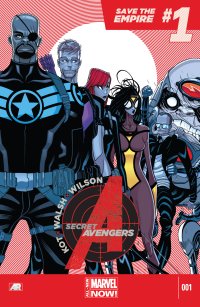 Secret Avengers, on the other hand, relaunches with a decidedly different approach than its predecessor. Previously, Nick Spencer and Nic Klein had made this into a super-powered espionage story, of a piece with Brubaker’s celebrated Captain America run, with a strong emphasis on the emotional wear and tear of the characters’ involvement in mind-wiped black ops. Interestingly, with Spencer giving way to Ales Kot, the tone of the book has shifted to something approaching Spencer’s own Superior Foes of Spider-Man, and Matt Fraction’s Hawkeye. Though Hawkeye, Black Widow, Spider-Woman, and the S.H.I.E.L.D. contingent remain the core of the team, and super-spying is more or less the name of the game, Kot has expanded his focus, adding M.O.D.O.K., among others, in supporting roles. Like Hawkeye and Superior Foes, the influence of crime novelists like Elmore Leonard or Carl Hiassen, and their eye for the peculiarities of the criminal underworld, is strong, with plot taking a back seat to quirky characterization, snappy dialog, and the affectionate undermining of familiar cliches. Kot does an excellent job of juggling his large cast, and this first issue is crammed with incident, from Natasha and Jessica’s “girls’ day out” being rudely interrupted, Hawkeye finding himself an situation that’s awkward even for him, a Fury vs Fury showdown that might not be the one you were expecting, punchouts, car chases, and a classical quote-off between M.O.D.O.K., and Marina Hill; for a 22-page superhero comic it’s rewardingly dense.
Secret Avengers, on the other hand, relaunches with a decidedly different approach than its predecessor. Previously, Nick Spencer and Nic Klein had made this into a super-powered espionage story, of a piece with Brubaker’s celebrated Captain America run, with a strong emphasis on the emotional wear and tear of the characters’ involvement in mind-wiped black ops. Interestingly, with Spencer giving way to Ales Kot, the tone of the book has shifted to something approaching Spencer’s own Superior Foes of Spider-Man, and Matt Fraction’s Hawkeye. Though Hawkeye, Black Widow, Spider-Woman, and the S.H.I.E.L.D. contingent remain the core of the team, and super-spying is more or less the name of the game, Kot has expanded his focus, adding M.O.D.O.K., among others, in supporting roles. Like Hawkeye and Superior Foes, the influence of crime novelists like Elmore Leonard or Carl Hiassen, and their eye for the peculiarities of the criminal underworld, is strong, with plot taking a back seat to quirky characterization, snappy dialog, and the affectionate undermining of familiar cliches. Kot does an excellent job of juggling his large cast, and this first issue is crammed with incident, from Natasha and Jessica’s “girls’ day out” being rudely interrupted, Hawkeye finding himself an situation that’s awkward even for him, a Fury vs Fury showdown that might not be the one you were expecting, punchouts, car chases, and a classical quote-off between M.O.D.O.K., and Marina Hill; for a 22-page superhero comic it’s rewardingly dense.
The art by Michael Walsh, with colors from Matthew Wilson, looks like what you might get if Sean Phillips or Michael Lark were trying to emulate the eccentric (and effective) layouts and paneling that David Aja’s been experimenting with on Hawkeye: sketchier and rougher than Aja’s work, and not quite as effective (yet, anyway): Walsh’s approach feels more like grace notes added to the script, rather than making his technique an integral part of the storytelling, which is where Aja excels. It’s effective and enjoyable (and his spider-bodied M.O.D.O.K. really hits the creepy absurdity of the current incarnation of the character), though I’ll be interested in seeing if it can break out of the shadow of its influences.
Which is a pretty good summation of the book as a whole: Marvel’s done an excellent job in recent years of making room for superhero comics that don’t quite fit the standard mold, series like Avengers Arena, Young Avengers, and FF. But there’s a danger that the Hawkeye/Superior Foes-derived “offbeat crime caper” approach can become a mold of its own, one too easy to emulate. There’s no doubt that Secret Avengers does a better job of this than, say, Infiinty Heist, but as Kot moves in and gets comfortable with the characters, I’d be very surprised if it doesn’t wind up forging an identity of its own.
Captain Marvel #1 Rating: 




Out of a Possible 5 Stars
Secret Avengers #1 Rating:





Out of a Possible 5 Stars
The Devil is Due in Dreary TP (Arcana, $12.95)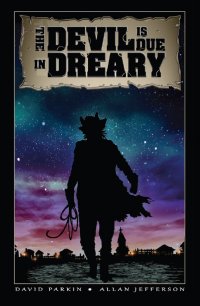
By Cat Taylor
The Devil is Due in Dreary was originally a mini-series that some of you may have already read, but now it has been collected into a trade paperback for the rest of us. It’s another comic book success story that managed to see print due to Kickstarter campaigns. Unlike most comic books that are licensed for movies, The Devil is Due in Dreary took the opposite approach. Film producer, Daryl Freimark, and writer, David Parkin, planned the movie and wrote the screenplay but decided to release it as a comic book mini-series and trade paperback before releasing the movie. Considering that few studios will give a decent budget and wide release to any movie that isn’t a sequel, remake, or adaptation of something else, this was a pretty sensible marketing technique. If you decide to read this book, the cinematic feel of the story will be immediately apparent.
Although classified as a horror comic, The Devil is Due in Dreary really only enters horror territory in the first few pages and in the climactic payoff. The majority of the book is a story of the struggle of two outsiders who get stuck in the small, isolated town of Dreary. The authority figures, and most of the residents, are convinced that the town is cursed and that the devil could be coming TONIGHT! They even have a poem that has been passed down from a previous generation that they have come to believe is a prophecy of the devil’s impending arrival. Unfortunately for the outsiders and the poor timing of their arrival, there are lines in the poem that lead the local preacher to believe they are harbingers of the devil and most of the townsfolk fall in line with this belief. The story is written in such a way that a reader would normally wonder if there even is a devil or if the townspeople are just completely delusional. However, the powerful opening pages let the reader know that there is some sort of “devil” involved somewhere. On one hand, I questioned whether it was a good idea to kill the ambiguity prior to the reveal with such blatant opening pages. On the other, the opening pages are what kept me reading until the end. The story is such a slow burn that the teaser at the beginning was helpful assurance that there was going to be a payoff at some point.
It’s no secret that with self-publishing being easier than ever, a lot a poor quality comics have flooded the market and often make readers reluctant to take a chance on something new, especially when they have shell out the big bucks for a trade paperback. However, both the writing and the art in The Devil is Due in Dreary hold up well in comparison with most of the work published by the big names like Marvel, DC, Dark Horse, or IDW. Even though the story and resolution in The Devil is Due in Dreary is far from the most original or innovative piece of work I’ve ever read (ANOTHER evil preacher cliché?), sometimes that doesn’t matter. On the contrary, horror fans often crave stories that remind them of old-school horror movies with variations on familiar themes. If the story is well-written and entertaining, a lack of originality is easily forgivable. If that’s what you’re looking for, The Devil is Due in Dreary delivers.
Rating: 




Out of a Possible 5 Stars